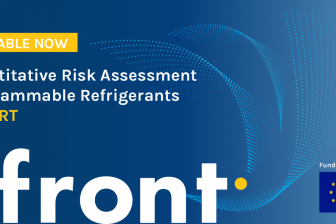Europe’s largest leakage size database for equipment using flammable refrigerants is now available online

LIFE FRONT has released two new databases relevant to flammable refrigerants
On October 8, LIFE FRONT published “Europe’s largest leakage size database” (the refrigerant leak size database plus the concentration database) for equipment using flammable refrigerants to help improve overall safety measures for systems using such refrigerants.
Publicly and freely accessible, Europe’s largest leakage size database is the first of its kind and is projected to keep growing. This resource was officially launched with a webinar on October 10 where the LIFE FRONT project team, together with industry stakeholders who assisted with data collection, explained the benefit of collating this kind of information.
In these two databases, risk parameters are shown realistically and based on the actual frequency of leaks, leak-hole sizes, and mass-flow rates with a fundamental approach to leak- time measurements. Both databases are to be considered as input parameters for safety standards, determining among others the allowable refrigerant charge sizes and system design parameters.
The refrigerant leak-size database provides a directory for leak-hole sizes and corresponding mass-flow rates in refrigeration, heat pump, and AC equipment, helping to inform configuration testing to determine safe operating limits for flammable refrigerants; the concentration database looks at identifying gas concentrations arising from refrigerant leaks in different parts of refrigeration, heat pump and AC systems.
“Industry’s experience with leaks is generally limited to equipment failures reported to the aftersales or quality departments,” explained Pauline Bruge of shecco, LIFE FRONT Project Coordinator. “However, there is limited input on leaks fixed in the field and virtually no info about leak flow rates.”
The databases bring an important added value: a statistical approach with information on leak flow rate in relation to the leak cause. This information will enable the participating manufacturers to conduct a thorough risk assessment, to adapt their mitigation measures to the identified leak causes and very importantly: to adapt design, relevant safety devices, and relevant charge size. “The database and the LIFE FRONT project can provide valuable inputs for changing product safety standards and increasing the allowable charge of flammable refrigerant in refrigeration, AC and heat pumps,” said Laure Meljac, NIBE’s Regional Manager for International Affairs, who partook in the project.
The LIFE FRONT project aims to remove barriers posed by standards for flammable refrigerants in refrigeration, air conditioning, and heat pump applications. It strives to improve system design to address flammability risk and thereby encourage wider uptake of climate-friendly alternatives to fluorinated gases. “The objective of the databases is to show real data on refrigerant leakage to be used as a basis for the standard-making process, replacing the current assumptions that don’t necessarily rely on realistic scenarios,” said Bruge. “Correct determination of the hole size is essential for handling of flammable HC refrigerants,” added U.K. Engineer and Project Consultant Daniel Colburn during his webinar presentation. “If it’s too small, you underestimate the potential hazard; too large and you over-engineer and over-price protective measures.”
Get involved and contribute
Other equipment manufacturers are invited to contribute to the project with their own data, which will remain confidential and anonymous at all times. Project partners are hopeful that the database will increase with further contributions in the near future, given that knowing “the leak rates are helpful for the improvement of products and services currently on the market,” said Werner Schwaiger of AHT, who were also involved with the data collection and presented during the webinar. “It’s also helpful for developing standards for the future”.
Also available: concentration development and leak simulation database
A study on concentration development and the leak-simulation database entitled “Recommended leak hole size and mass flow rates by system and application characteristics” is now also available for download on the databases webpage. This report outlines the background of the current charge-size limits of various standards. It also provides a brief overview of available studies on leakages and their main results. A final update of this report will be provided at the end of the project in 2020.
The webinar was the second in the series of LIFE FRONT webinars, which will be offered throughout the project’s duration to update the public on developments and outcomes achieved.
The slides are available in the Downloads section, while you can watch the video recording here!







